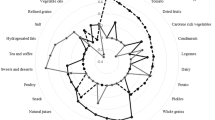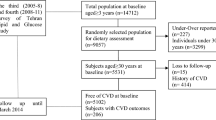Abstract
Background/Objectives:
The purpose of this study was to explore the association of legume intake (beans, chickpeas, lentils and so on), as part of a low-glycemic index diet, with the risk of cardiovascular events in the Iranian middle- and old-aged people.
Subjects/Methods:
A total of 6504 subjects living in the three counties of Iran participated in the Isfahan Cohort Study. Totally, 6323 were free of cardiovascular disease (CVD) at their baseline examination. Of the 6323 individuals, 5398 participants remained in the study for 7 years of follow-up. They have been contacted every 2 years for possible occurrence of CVD events including fatal and non-fatal myocardial infarction, unstable angina, fatal and non-fatal stroke, and sudden cardiac death. The frequency of legume intake was estimated using a food frequency questionnaire. Cox proportional hazards models with shared gamma frailty terms were used to model time to event outcomes.
Results:
After a median follow-up of 6.8 years, 427 cardiovascular events occurred. The intake of legumes in different tertiles of consuming measure was associated with 34% lower risk of CVD in old-aged people, after controlling for the other probable confounders (hazard ratio and 95% CI: 0.66 (0.45, 0.98), P-value=0.039). However, there was no significant association between the frequency of consuming legumes and CVD events in the middle-aged people.
Conclusions:
The present study indicated a strong inverse relationship between legume intake and the risk of cardiovascular events in old-aged Iranian people.
This is a preview of subscription content, access via your institution
Access options
Subscribe to this journal
Receive 12 print issues and online access
$259.00 per year
only $21.58 per issue
Buy this article
- Purchase on Springer Link
- Instant access to full article PDF
Prices may be subject to local taxes which are calculated during checkout
Similar content being viewed by others
References
Murray CJ, Lopez AD . Mortality by cause for eight regions of the world: Global Burden of Disease Study. Lancet 1997; 349: 1269–1276.
World Health Organization Mortality Estimates by Cause, Age, and Sex for the Year 2008. WHO: Geneva, 2011.
Tunstall-Pedoe H . Preventing chronic diseases. A vital investment: WHO global report. Int J Epidemiol 2006; 35: 1107.
Forman D, Bulwer BE . Cardiovascular disease: optimal approaches to risk factor modification of diet and lifestyle. Curr Treat Options Cardiovasc Med 2006; 8: 47–57.
Willett W . Nutritional Epidemiology. Oxford University Press: New York, NY, USA, 1990.
Anderson JW, Smith BM, Washnock CS . Cardiovascular and renal benefits of dry bean and soybean intake. Am J Clin Nutr 1999; 70: 464S–474S.
Liu S, Buring JE, Sesso HD, Rimm EB, Willett WC, Manson JE . A prospective study of dietary fiber intake and risk of cardiovascular disease among women. J Am Coll Cardiol 2002; 39: 49–56.
Pietinen P, Rimm EB, Korhonen P, Hartman AM, Willett WC, Albanes D et al. Intake of dietary fiber and risk of coronary heart disease in a cohort of Finnish men. The Alpha-Tocopherol, Beta-Carotene Cancer Prevention Study. Circulation 1996; 94: 2720–2727.
Moat SJ, Lang D, McDowell IF, Clarke ZL, Madhavan AK, Lewis MJ . Folate, homocysteine, endothelial function and cardiovascular disease. J Nutr Biochem 2004; 15: 64–79.
Gums JG . Magnesium in cardiovascular and other disorders. Am J Health Syst Pharm 2004; 61: 1569–1576.
Fox CH, Mahoney MC, Ramsoomair D, Carter CA . Magnesium deficiency in African-Americans: does it contribute to increased cardiovascular risk factors? J Natl Med Assoc 2003; 95: 257–262.
Saari JT . Copper deficiency and cardiovascular disease: role of peroxidation, glycation, and nitration. Can J Physiol Pharmacol 2000; 78: 848–855.
Anderson JW, Major AW . Pulses and lipaemia, short- and long-term effect: potential in the prevention of cardiovascular disease. Br J Nutr 2002; 88: S263–S271.
Bazzano LA, He J, Ogden LG, Loria CM, Whelton PK . Dietary fiber intake and reduced risk of coronary heart disease in US men and women: the National Health and Nutrition Examination Survey I Epidemiologic Follow-up Study. Arch Intern Med 2003; 163: 1897–1904.
Bazzano LA, He J, Ogden LJ, Loria C, Vupputuri S, Myers L et al. Legume consumption and risk of coronary heart disease in US men and women: NHANES I Epidemiologic Follow-up Study. Arch Intern Med 2001; 161: 2573–2578.
Geil PB, Anderson JW . Nutrition and health implications of dry beans: a review. J Am Coll Nutr 1994; 13: 549–558.
Serrano J, Goni I . Effects of black bean Phaseolus vulgaris consumption on the nutritional status of Guatemalan population. Arch Latinoam Nutr 2004; 54: 36–44.
Liu S, Stampfer MJ, Hu FB, Giovannucci E, Rimm E, Manson JE et al. Whole-grain consumption and risk of coronary heart disease: results from the Nurses’ Health Study. Am J Clin Nutr 1999; 70: 412–419.
Jenkins DJ, Kendall CW, Augustin LS, Mitchell S, Sahye-Pudaruth S, Blanco Mejia S et al. Effect of legumes as part of a low glycemic index diet on glycemic control and cardiovascular risk factors in type 2 diabetes mellitus: a randomized controlled trial. Arch Intern Med 2012; 172: 1653–1660.
Bhattacharya S, Malleshi NG . Physical, chemical and nutritional characteristics of premature-processed and matured green legumes. J Food Sci Technol 2012; 49: 459–466.
Han H, Baik BK . Antioxidant activity and phenolic content oflentils (Lens culinaris, chickpeas (Cicer arietinum L.), peas (Pisum sativum L.) and soybeans (Glycine max), and their quantitative changes during processing. Int J Food Sci Technol 2008; 43: 1971–1978.
Anderson JW, Hanna TJ . Impact of nondigestible carbohydrates on serum lipoproteins and risk for cardiovascular disease. J Nutr 1999; 129: S1457–S1466.
Tourlouki E, Matalas AL, Panagiotakos DB . Dietary habits and cardiovascular disease risk in middle-aged and elderly populations: a review of evidence. Clin Interv Aging 2009; 4: 319–330.
Sarrafzadegan N, Talaei M, Sadeghi M, Kelishadi R, Oveisgharan S, Mohammadifard N et al. The Isfahan cohort study: rationale, methods and main findings. J Hum Hypertens 2011; 25: 545–553.
Sarraf-Zadegan N, Sadri G, Malek Afzali H, Baghaei M, Mohammadi Fard N, Shahrokhi S et al. Isfahan Healthy Heart Programme: a comprehensive integrated community-based programme for cardiovascular disease prevention and control. Design, methods and initial experience. Acta Cardiol 2003; 58: 309–320.
Sarrafzadegan N, Baghaei A, Sadri G, Kelishadi R, Malekafzali H, Boshtam M et al. Isfahan Healthy Heart Program: Evaluation of comprehensive, community-based interventions for non-communicable disease prevention. Prev Control 2006; 2: 73–84.
Sarrafzadegan N, Kelishadi R, Esmaillzadeh A, Mohammadifard N, Rabiei K, Roohafza H et al. Do lifestyle interventions work in developing countries? Findings from the Isfahan Healthy Heart Program in the Islamic Republic of Iran. Bull World Health Organ 2009; 87: 39–50.
Mohammadifard N, Sarrafzadegan N, Nouri F, Sajjadi F, Alikhasi H, Maghroun M et al. Using factor analysis to identify dietary patterns in Iranian adults: Isfahan Healthy Heart Program. Int J Public Health 2012; 57: 235–241.
Clayton DG . A model for association in bivariate life tables and its application in epidemiological studies of familial tendency in chronic disease incidence. Biometrika 1978; 65: 141–151.
Hougaard P . Analysis of Multivariate Survival Data. Springer: New York, 2000.
Darmadi-Blackberry I, Wahlqvist ML, Kouris-Blazos A, Steen B, Lukito W, Horie W et al. Legumes: the most important dietary predictor of survival in older people of different ethnicities. Asia Pacific J Clin Nutr 2004; 13: 217–220.
Flock MR, Kris-Etherton PM . Dietary guidelines for Americans 2010: implications for cardiovascular disease. Curr Atheroscler Rep 2011; 13: 499–507.
Jang Y, Lee JH, Kim OY, Park HY, Lee SY . Consumption of whole grain and legume powder reduces insulin demand, lipid peroxidation, and plasma homocysteine concentrations in patients with coronary artery disease: randomized controlled clinical trial. Arterioscler Thromb Vasc Biol 2001; 21: 2065–2071.
Mozaffarian D, kumanyika SK, Lemaitre RN, Olson JL, Gl Burke, Siscovick DS . Cereal, fruit and vegetable fiber intake and the risk of cardiovascular disease in older individuals. JAMA 2003; 289: 1659–1666.
Pereira MA, Pins JJ . Dietary fiber and cardiovascular disease: experimental and epidemiologic advances. Curr Atheroscler Rep 2000; 2: 494–502.
Jenkins DJ, Axelsen M, Kendall CW, Augustin LS, Vuksan V, Smith U . Dietary fibre lente carbohydrates and the insulin-resistant diseases. Br J Nutr 2000; 83: S157–163.
Erkkila AT, Lichtenstein AH . Fiber and cardiovascular disease risk: how strong is the evidence? J Cardiovasc Nurs 2006; 21: 3–8.
Hosseinpour-Niazi S, Mirmiran P, Amiri Z, Azizi F . Dietary legumes intake and metabolic syndrome and its component in adults. J Endocrinol Metab 2011; 12: 594–602.
Willett WC, Howe GR, Kushi LH . Adjustment for total energy intake in epidemiologic studies. Am J Clin Nutr 1997; 65: 1220S–1228S.
Oh S, Hong M . Within-and between-person variation of nutrient intakes of older people in Korea. Eur J Clin Nutr 1999; 53: 625–629.
Ogawa K, Tsubono Y, Nishino Y, Watanabe Y, Ohkubo T, Watanabe T et al. Inter-and intra-individual variation of food and nutrient consumption in a rural Japanese population. Eur J Clin Nutr 1999; 53: 781–785.
Acknowledgements
We would like to acknowledge the ICS staff and collaborators for their contribution.
Author information
Authors and Affiliations
Corresponding author
Ethics declarations
Competing interests
The authors declare no conflict of interest.
Rights and permissions
About this article
Cite this article
Nouri, F., Sarrafzadegan, N., Mohammadifard, N. et al. Intake of legumes and the risk of cardiovascular disease: frailty modeling of a prospective cohort study in the Iranian middle-aged and older population. Eur J Clin Nutr 70, 217–221 (2016). https://doi.org/10.1038/ejcn.2015.153
Received:
Revised:
Accepted:
Published:
Issue Date:
DOI: https://doi.org/10.1038/ejcn.2015.153
This article is cited by
-
New insights of minimum requirement on legumes (Fabaceae sp.) daily intake in Malaysia
BMC Nutrition (2023)
-
Longitudinal association of dietary habits and the risk of cardiovascular disease among Iranian population between 2001 and 2013: the Isfahan Cohort Study
Scientific Reports (2023)
-
Association between latent profile of dietary intake and cardiovascular diseases (CVDs): Results from Fasa Adults Cohort Study (FACS)
Scientific Reports (2023)
-
The Pandemic of Coronary Heart Disease in the Middle East and North Africa: What Clinicians Need to Know
Current Atherosclerosis Reports (2023)
-
Longitudinal association between an overall diet quality index and latent profiles of cardiovascular risk factors: results from a population based 13-year follow up cohort study
Nutrition & Metabolism (2021)



